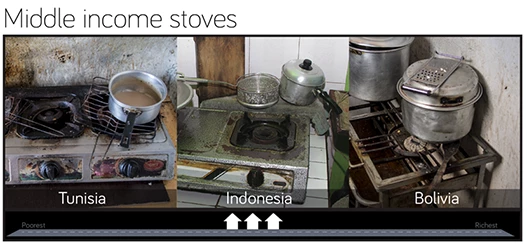About 30 years ago, I lived in a village in China's Xinjiang province where I remember having to collect firewood for cooking and heating as part of my chores . In fact, as part of summer homework, we also needed to turn in a big bundle of firewood when the school started in the fall, which would be used to heat the classroom, together with coal.
Cooking with firewood was not only a tough job because of all the smoke but also required skills and experience. If the fire was not well controlled, the rice could be easily burned. Before I was old enough to take on this job, our family moved to a city apartment with access to district heating and we also started to use liquefied petroleum gas (LPG) for cooking. Since then, our daily life has been transformed .
However, not everyone is as lucky as me.
Globally, nearly 3 billion people still rely on traditional cooking fuel and technologies, which contributes to about 4 million premature deaths annually due to associated household air pollution . According to a joint study by the World Bank and Institute for Health Metrics and Evaluation, the estimated welfare losses is a staggering US$1.52 trillion annually.
Where do we stand?
Why is it so hard?
Access to modern energy cooking services is a development issue faced by the poor. The nearly 3 billion people are among the bottom 40% of the global population. We can take a glimpse into these people’s lives through “ Dollar Street,” a website that shows photos taken from hundreds of homes around the world, grouping them by income level. These photos allow us to peek into the kitchens of poor households who are still cooking with traditional fuels and stoves. You do not have to be a poor or have my childhood experience to see the issue.



Switching to modern clean fuels is the most effective way to reduce household air pollution . However, it is more costly than traditional biomass and requires a delivery infrastructure. In rural areas, where people have budget constraints and easy access to free or cheap traditional biomass, households will rarely prioritize cooking fuel expenses. Therefore, large-scale fuel switching is unlikely to occur in these areas unless local economies become substantially more developed or there is continued public funding to bridge the affordability gap.
Some countries have implemented LPG subsidies to promote clean cooking. However, LPG fuel subsidies are often regressive in nature, could add to the fiscal pressure many economies already struggle with, and are subject to leakages. Some countries have promoted improved cookstoves without fuel switching. However, stove performance indicators (e.g. fuel efficiency, emissions, and durability) and adoption are often problematic. More importantly, most access deficit countries have yet to give priority and resources to promote modern energy cooking solutions which are vastly underfunded. Based on the Energizing Finance report from Sustainable Energy for All, across the 20 countries with the biggest gaps in access, trackable investment in residential cooking solutions averaged just $32 million a year in 2013-14, compared to an IEA estimated annual need of at least $4.4 billion globally.
How to move the needle?
The World Bank currently has an active lending portfolio of over $300 million in the efficient and clean cooking and heating sector (excluding solutions that require networks, such as natural gas for cooking and district heating). Most of them have been supported by technical assistance from ESMAP’s Efficient and Clean Cooking and Heating program, benefiting 3.6 million households or over 18 million people, in 14 countries. The operational experience accumulated so far provides some important lessons:
- A national program with high-level support is essential for scaling-up access to modern energy cooking services . While such programs need to involve stakeholders from a wide variety of positions, roles and levels (i.e., local, provincial, national and international; public, civil society and private sector), there is no substitute for high-level political, technical and financial support from national leaders and agencies. This support is a key success factor that takes time to build and requires continual engagement to maintain.
- Incentives will be needed to achieve universal access to modern energy cooking services. Market forces and mechanisms are powerful tools for ensuring a sustainable supply of modern cooking technologies and should be harnessed in a way that helps the private sector to develop, market, and deliver modern cooking solutions. However, if left to market forces alone, access will be limited by affordability and other constraints that affect mainly poor households, particularly in less developed and more remote areas. Thus, government policies are needed to (i) establish and maintain adequate levels of incentives to either the supply side, the demand side, or both and (ii) design and implement effective incentive allocation mechanisms to attract private-sector participation, incentivize innovations, and target households who have affordability gaps. The World Bank has worked with several client countries (e.g. in China, Mongolia, Indonesia, Lao PDR, Bangladesh, Uganda, Kenya, Rwanda, Madagascar, Ethiopia) to implement results-based financing frameworks and demonstrated that it can be an effective way to attract the private sector and promote innovations in delivering cooking/heating solutions.
- Local innovation and contextualized solutions are critical for the long-term sustainability. Cooking is a very contextualized system and there is no one-fits-all-solution. Although there are common barriers, the best solution will vary from one place to another because of differences in behavior, culture, resources, institutions, and market conditions. Therefore, learning from international experience including the latest technology innovations and then empowering development of the contextualized solutions that meet user preferences will be the key, because those solutions will likely be more sustainable. And only when the solutions are sustainable, they can be truly transformative.


Join the Conversation